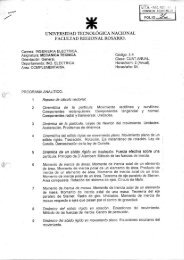7.Momento_lineal_y_colisiones
You also want an ePaper? Increase the reach of your titles
YUMPU automatically turns print PDFs into web optimized ePapers that Google loves.
0 m 1 v 1f sin m 2 v 2f sin <br />
(9.25)<br />
olisiones en dos dimensiones<br />
where the minus sign in Equation 9.25 comes from the fact that after the collision, particle<br />
2 has a y component of velocity that is downward. We now have two independent<br />
equations. As long as no more than two of the seven quantities in Equations 9.24 and<br />
9.25 are unknown, we can solve the problem.<br />
If the collision is elastic, we can also use Equation 9.16 (conservation of kinetic energy)<br />
with v 2i 0 to give<br />
¿Qué ocurre si la colisión tiene lugar en un plano?<br />
1<br />
2 m 1v1i 2 <br />
Ejemplo<br />
1 2 m 1v1f 2 1 2 m 2v 2f<br />
2<br />
(9.26)<br />
v 1f sin θ<br />
v 1f<br />
v 1i<br />
–v 2f sin φ<br />
v 1f cos θ<br />
θ<br />
φ<br />
v 2f cos φ<br />
(a) Before the collision<br />
(b) After the collision<br />
Active Figure 9.13 An elastic glancing collision between two particles.<br />
v 2f<br />
At the Active Figures lin<br />
at http://www.pse6.com, you<br />
can adjust the speed and<br />
position of the blue particle<br />
and the masses of both<br />
particles to see the effects.<br />
EL objeto 1 choca, sin apenas rozarlo, con el objeto 2<br />
La partícula 2 se encuentra inicialmente en reposo<br />
Suponemos que el choque es elástico<br />
onservación de la cantidad de movimiento<br />
onservación de la energía cinética<br />
ecuaciones y 4 incógnitas<br />
necesitaríamos como dato una de las cuatro magnitudes




